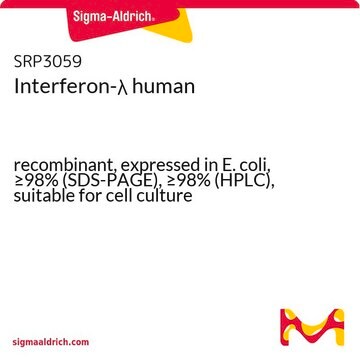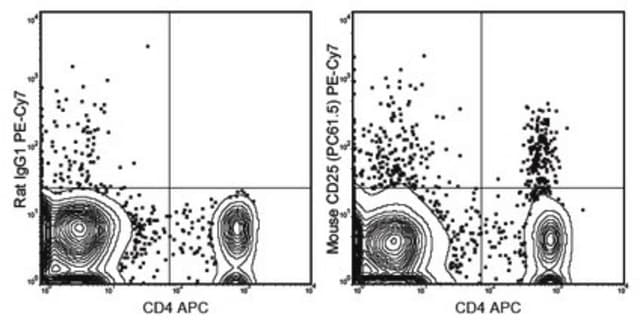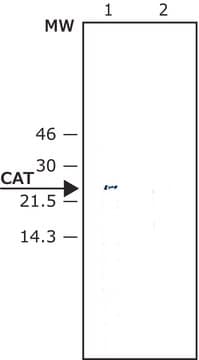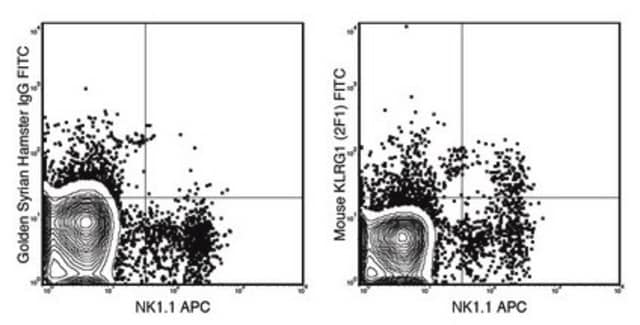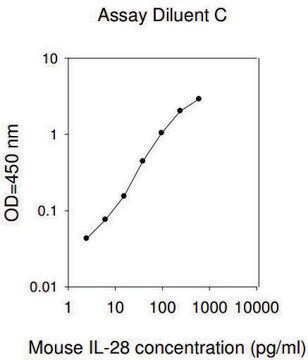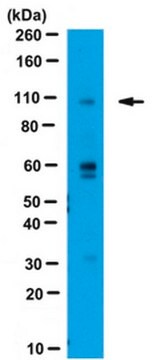MABF227
Anti-Interferon Lambda 4, clone 4G1 Antibody
clone 4G1, 1 mg/mL, from mouse
Synonym(s):
Interferon lambda-4, IFN-lambda-4
About This Item
Recommended Products
biological source
mouse
Quality Level
antibody form
purified immunoglobulin
antibody product type
primary antibodies
clone
4G1, monoclonal
species reactivity
nonhuman primates, human
should not react with
porcine, giant panda, canine, bat, bovine
concentration
1 mg/mL
technique(s)
ELISA: suitable
flow cytometry: suitable
immunocytochemistry: suitable
immunohistochemistry: suitable
western blot: suitable
isotype
IgG1κ
NCBI accession no.
UniProt accession no.
shipped in
wet ice
target post-translational modification
unmodified
Gene Information
bat ... Loc102244039(102244039)
human ... IFNL4(101180976)
General description
Specificity
Immunogen
Application
ELISA Analysis: A representative lot was conjugated with a sulfo-tag (MSD) and employed as the detection antibody in a sandwich ELISA application. An exogenously expressed IFNL4 HaloTag fusion was found secreted in the culture media from IFNL4-Halo construct-transfected, but not mock-transfected HepG2 cells (Onabajo, O.O., et al. (2015). J. Interferon. Cytokine Res. 35(11):888-900).
Flow Cytometry Analysis: A representative lot immunostained HepG2 cells transfected to express HaloTag fusion IFN-λ4 orthologs of elephant, human and non-human primate (chimpanzee, orangutan, rhesus, marmoset, cynomolgus) origins, but not cells expressing IFNL4 of bovine, bat, canine, panda, and porcine species (Paquin, A., et al. (2016). J. Interferon Cytokine Res. 36(1):30-36).
Immunocytochemistry Analysis: Representative lots immunostained HepG2 cells transfected to express HaloTag fusion of IFN-λ4 orthologs of elephant, human and non-human primate (chimpanzee, orangutan, rhesus, marmoset, cynomolgus) origins (Paquin, A., et al. (2016). J. Interferon Cytokine Res. 36(1):30-36; Prokunina-Olsson, L., et al. (2013). Nat. Genet. 45(2):164-171).
Immunocytochemistry Analysis: A representative lot detected a time-dependent induction of IFNL4 expression in hepatocytes from a donor heterozygous for ss469415590 (TT/ΔG) upon PolyI:C treatment or hepatitis C virus (HCV) strain JFH1HCV infection in cultures (Prokunina-Olsson, L., et al. (2013). Nat. Genet. 45(2):164-171).
Western Blotting Analysis: A representative lot detected HaloTag fusion IFN-λ4 orthologs of elephant, human and non-human primate (chimpanzee, orangutan, rhesus, marmoset, cynomolgus) origins, but not IFNL4 of bovine, bat, canine, panda, and porcine species transiently expressed in HepG2 cells (Paquin, A., et al. (2016). J. Interferon Cytokine Res. 36(1):30-36).
Western Blotting Analysis: A representative lot detected exogenously expressed IFNL4 HaloTag fusion constructs in transfected COS-7 and HepG2 cells, but not in untransfected cells. Clone 4G1 does not cross-react with IFN-alpha or IL-28B (Prokunina-Olsson, L., et al. (2013). Nat. Genet. 45(2):164-171).
Quality
Western Blotting Analysis: 1.0 µg/mL of this antibody detected 0.1 µg of human IFNL4 recombinant protein.
Target description
Physical form
Not finding the right product?
Try our Product Selector Tool.
Storage Class Code
12 - Non Combustible Liquids
WGK
WGK 1
Flash Point(F)
Not applicable
Flash Point(C)
Not applicable
Certificates of Analysis (COA)
Search for Certificates of Analysis (COA) by entering the products Lot/Batch Number. Lot and Batch Numbers can be found on a product’s label following the words ‘Lot’ or ‘Batch’.
Already Own This Product?
Find documentation for the products that you have recently purchased in the Document Library.
Our team of scientists has experience in all areas of research including Life Science, Material Science, Chemical Synthesis, Chromatography, Analytical and many others.
Contact Technical Service

